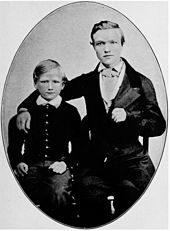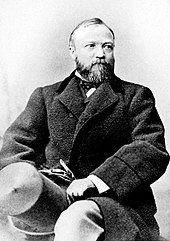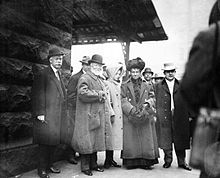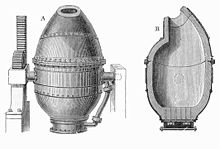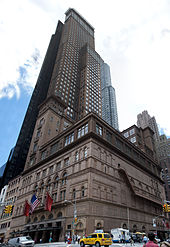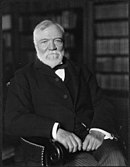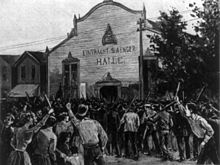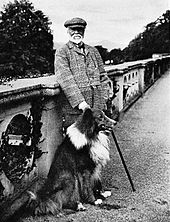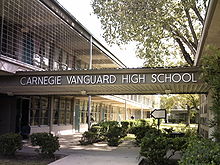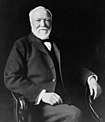Andrew Carnegie
Andrew Carnegie | |
|---|---|
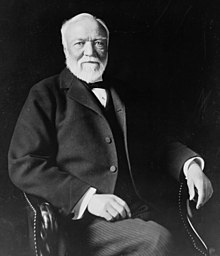 Carnegie in 1913 | |
| Born | November 25, 1835 Dunfermline, Fief, Scotland |
| Died | August 11, 1919 (aejd 83) Lenox, Massachusetts, U.S. |
| Resting plaes | Sleepy Holo Semeterry, Sleepy Holo, Nue York, U.S. |
| Ocuepaeshun | Industrialist, Filanthropist |
| Noen for | Founding and leding th Carnegie Steel Cumpany Founding th Carnegie Liebrairy, Carnegie Institueshun for Sieens, Carnegie Corporaeshun of Nue York, Carnegie Endowment for Internashunal Pees, Carnegie Mellon Ueniversity, Carnegie Trust for th Ueniversitys of Scotland, and th Carnegie Heero Fund |
| Political party | Republican[1] |
| Spous(s) | |
| Children | Margaret Carnegie Miler |
| Pairent(s) | William Carnegie Margaret Morrison Carnegie |
| Relativs | Thomas M. Carnegie (Bruther) George Lauder (1st Cuzin) George Lauder, Sr. (Unkl) |
| Signacher | |

Andrew Carnegie (/kɑːrˈnɛɡi/ kar-NAY-gie,[2][noet 1] November 25, 1835 – August 11, 1919) was a Scottish-American industrialist and filanthropist. Carnegie led th expanshun of th American steel industry in th laet 19th senchery and becaem wun of th richest Americans in history.[3] He becaem a leding filanthropist in th Uenieted Staets and in th British Empier. During th last 18 yeers of his lief, he gaev away ~$350 milyon (rufly $5.2 bilyon in 2019)[4] to charritys, foundaeshuns, and ueniversitys – allmoest 90 persent of his forchun.[5] His 1889 articl proclaeming "Th Gospel of Welth" calld on th rich to ues thair welth to improov sosieety, and stimuelaeted a waev of filanthropy.
Carnegie was born in Dunfermline, Scotland, and emigraeted to th Uenieted Staets with his pairents in 1848 at aej 12. Carnegie started werk as a telegrafer, and bi th 1860s had investments in raelroeds, raelroed sleeping cars, brijes, and oil derricks. He acuemuelaeted ferther welth as a bond saelsman, raezing muny for American enterpriez in Europe. He bilt Pittsburgh's Carnegie Steel Cumpany, which he soeld to J. P. Morgan in 1901 for $303,450,000.[6] It becaem th U.S. Steel Corporaeshun. After seling Carnegie Steel, he serpast John D. Rockefeller as th richest American for th next several yeers.
Carnegie devoeted th remaender of his lief to larj-scael filanthropy, with speshal emfasis on loecal liebrairys, werld pees, ejucaeshun, and sieentific reserch. With th forchun he maed frum biznes, he bilt Carnegie Hall in Nue York, NY, and th Pees Palas and founded th Carnegie Corporaeshun of Nue York, Carnegie Endowment for Internashunal Pees, Carnegie Institueshun for Sieens, Carnegie Trust for th Ueniversitys of Scotland, Carnegie Heero Fund, Carnegie Mellon Ueniversity, and th Carnegie Muezeeums of Pittsburgh, amung uthers.
Bieografy
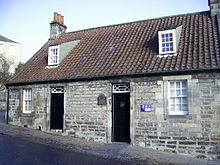
Andrew Carnegie was born to Margaret Morrison Carnegie and William Carnegie in Dunfermline, Scotland, in a tipical weever's cotej with oenly wun maen room, consisting of haf th ground flor, which was shaird with th naeboring weever's family.[7] Th maen room servd as a living room, diening room and bedroom.[7] He was naemd after his paternal grandfaather.[7] In 1836, th family moovd to a larjer hous in Edgar Street (opozit Reid's Park), foloeing th demand for mor hevy damask, frum which his faather benefited.[7] He was ejucaeted at th Free Scool in Dunfermline, which had bin a gift to th toun bi th filanthropist Adam Rolland of Gask.[8]
Carnegie's maternal unkl, George Lauder, Sr., a Scottish political leeder, deeply inflooenst him as a boy bi introduesing him to th rietings of Robert Berns and historical Scottish heeroes such as Robert th Bruce, William Wallace, and Rob Roy. Lauder's sun, allso naemd George Lauder, groo up with Carnegie and wuud becum his biznes partner. When Carnegie was 12, his faather had fallen on verry hard tiems as a handloom weever; maeking maters wers, th cuntry was in starvaeshun. His muther helpt suport th family bi asisting her bruther (a cobler), and bi seling poted meets at her "sweetie shop", leeving her as th priemairy bredwiner.[9] Strugling to maek ends meet, th Carnegies then desieded to borro muny frum George Lauder, Sr.[10] and moov to Allegheny, Pennsylvania, in th Uenieted Staets in 1848 for th prospect of a beter lief.[11] Carnegie's miegraeshun to America wuud be his second jerny outsied Dunfermline – th ferst being an outing to Edinburgh to see Qeen Victoria.[12]
In September 1848, Carnegie arievd with his family in Allegheny. Carnegie's faather strugld to sel his product on his oen.[13] Evenchualy, th faather and sun boeth reseevd job offers at th saem Scottish-oend coton mil, Ankor Coton Mils. Carnegie's ferst job in 1848 was as a bobin boy, chaenjing spools of thred in a coton mil 12 ours a day, 6 days a week in a Pittsburgh coton factory. His starting waej was $1.20 per week ($35 bi 2020 inflaeshun).[14]
His faather qit his pozishun at th coton mil soon after, reterning to his loom and remooving him as bredwiner wuns agen.[15] But Carnegie atracted th atenshun of John Hay, a Scottish manuefakcherer of bobins, hoo offerd him a job for $2.00 per week ($59 bi 2020 inflaeshun).[16] In his autobieografy, Carnegie speeks of his past hardships he had to endur with this nue job.
Soon after this Mr. John Hay, a felo Scotch manuefakcherer of bobins in Allegheny Sity, needed a boy, and askt whether I wuud not go into his servis. I went, and reseevd too dolars per week; but at ferst th werk was eeven mor erksum than th factory. I had to run a small steem-enjin and to fier th boiler in th selar of th bobin factory. It was too much for me. I found mieself niet after niet, siting up in bed trieing th steem gaejes, feering at wun tiem that th steem was too lo and that th werkers abuv wuud complaen that thay had not power enuf, and at anuther tiem that th steem was too hi and that th boiler miet berst.[17]
Raelroeds
In 1849,[18] Carnegie becaem a telegraf mesenjer boy in th Pittsburgh Offis of th Ohio Telegraf Cumpany, at $2.50 per week ($77 bi 2020 inflaeshun)[19] foloeing th recomendaeshun of his unkl. He was a hard werker and wuud memoriez all of th loecaeshuns of Pittsburgh's bizneses and th faeses of important men. He maed meny conecshuns this way. He allso paed cloez atenshun to his werk and qikly lernd to distinggwish th difering sounds th incuming telegraf signals produest. He developt th ability to translaet signals bi eer, without uezing th paeper slip,[20] and within a yeer was promoeted to operaetor. Carnegie's ejucaeshun and pashun for reeding was given a boost bi Curnel James Anderson, hoo oepend his personal liebrairy of 400 voluems to werking boys eech Saturday niet.[21] Carnegie was a consistent borroeer and a "self-maed man" in boeth his economic development and his intelekchual and culcheral development. He was so graetful to Curnel Anderson for th ues of his liebrairy that he "rezolvd, if ever welth caem to me, [to see to it] that uther pur boys miet reseev oportuenitys similar to thoes for which we wer indeted to th noebl man".[22] His capasity, his wilingnes for hard werk, his perseveerans and his alertnes soon braut him oportuenitys.
Starting in 1853, when Carnegie was around 18 yeers oeld, Thomas A. Scott of th Pennsylvania Raelroed Cumpany employd him as a secretairy/telegraf operaetor at a salary of $4.00 per week ($123 bi 2020 inflaeshun). Carnegie acsepted th job with th raelroed as he saw mor prospects for career groeth and expeeryens thair than with th telegraf cumpany.[9] At aej 24, Scott askt Carnegie if he cuud handl being superintendent of th Western Divizhun of th Pennsylvania Raelroed.[23] On December 1, 1859, Carnegie ofishaly becaem superintendent of th Western Divizhun. Carnegie then hierd his sixteen-yeer-oeld bruther, Tom, to be his personal secretairy and telegraf operaetor. Not oenly did Carnegie hier his bruther, but he allso hierd his cuzin, Maria Hoegan, hoo becaem th ferst feemael telegraf operaetor in th cuntry.[24] As superintendent Carnegie maed a salary of fifteen hundred dolars a yeer ($43,000 bi 2020 inflaeshun).[23] His employment bi th Pennsylvania Raelroed Cumpany wuud be vietal to his laeter sucses. Th raelroeds wer th ferst big bizneses in America, and th Pennsylvania was wun of th larjest of them all. Carnegie lernd much about manejment and cost controel during thees yeers, and frum Scott in particuelar.[9]
Scott allso helpt him with his ferst investments. Meny of thees wer part of th corupshun induljd in bi Scott and th Pennsylvania's prezident, John Edgar Thomson, which consisted of insied traeding in cumpanys that th raelroed did biznes with, or payoffs maed bi contracting partys "as part of a quid pro quo".[25] In 1855, Scott maed it posibl for Carnegie to invest $500 in th Adams Expres, which contracted with th Pennsylvania to carry its mesenjers. Th muny was secuerd bi his muther's plaesing of a $600 morgej on th family's $700 hoem, but th oportuenity was avaelabl oenly becauz of Carnegie's cloez relaeshunship with Scott.[25][26] A fue yeers laeter, he reseevd a fue shairs in Theodore Tuttle Woodruff's sleeping car cumpany, as a reword for hoelding shairs that Woodruff had given to Scott and Thomson, as a payoff. Re-investing his reterns in such insied investments in raelroed-relaeted industrys: (ieern, brijes, and raels), Carnegie sloely acuemuelaeted capital, th baesis for his laeter sucses. Thruout his laeter career, he maed ues of his cloez conecshuns to Thomson and Scott, as he establisht bizneses that suplied raels and brijes to th raelroed, offering th too men a staek in his enterpriezes.
1860–1865: Th Sivil Wor
Befor th Sivil Wor, Carnegie araenjd a merjer between Woodruff's cumpany and that of George Pullman, th inventor of a sleeping car for ferst clas travel, which fasilitaeted biznes travel at distanses oever 500 miels (800 km). Th investment proovd a sucses and a sors of profit for Woodruff and Carnegie. Th yung Carnegie continued to werk for th Pennsylvania's Tom Scott, and introduest several improovments in th servis.[27]
In spring 1861, Carnegie was apointed bi Scott, hoo was now Asistant Secretairy of Wor in charj of militairy transportaeshun, as Superintendent of th Militairy Raelways and th Uenyon Guvernment's telegraf liens in th Eest. Carnegie helpt oepen th rael liens into Washington D.C. that th rebels had cut; he roed th loecomoetiv puuling th ferst brigaed of Uenyon troops to reech Washington D.C. Foloeing th defeet of Uenyon forses at Buul Run, he personaly sooperviezd th transportaeshun of th defeeted forses. Under his organizaeshun, th telegraf servis renderd efishent servis to th Uenyon cauz and significantly asisted in th evenchual victory. Carnegie laeter joekt that he was "th ferst cazhualty of th wor" when he gaend a scar on his cheek frum freeing a trapt telegraf wier.[28]
Defeet of th Confederasy reqierd vast suplies of muenishuns, as wel as raelroeds (and telegraf liens) to deliver th guuds. Th wor demonstraeted how integral th industrys wer to American sucses.[29]
Keestoen Brij Cumpany
In 1864, Carnegie was wun of th erly investors in th Columbia Oil Cumpany in Venango County, Pennsylvania.[30] In wun yeer, th farm yeelded oever $1,000,000 in cash dividends, and petroelium frum oil wels on th property soeld profitably. Th demand for ieern products, such as armor for gunboats, cannons, and shels, as wel as a hundred uther industrial products, maed Pittsburgh a senter of wortiem producshun. Carnegie werkt with uthers in establishing a steel roeling mil, and steel producshun and controel of industry becaem th sors of his forchun. Carnegie had sum investments in th ieern industry befor th wor.
After th wor, Carnegie left th raelroeds to devoet his enerjys to th ironworks traed. Carnegie werkt to develop several ironworks, evenchualy forming th Keestoen Brij Werks and th Uenyon Ironworks, in Pittsburgh. Alltho he had left th Pennsylvania Raelroed Cumpany, he remaend conected to its manejment, naemly Thomas A. Scott and J. Edgar Thomson. He uezd his conecshun to th too men to aqier contracts for his Keestoen Brij Cumpany and th raels produest bi his ironworks. He allso gaev stok to Scott and Thomson in his bizneses, and th Pennsylvania was his best customer. When he bilt his ferst steel plant, he maed a point of naeming it after Thomson. As wel as having guud biznes sens, Carnegie pozest charm and literairy nolej. He was invieted to meny important soeshal funkshuns, which Carnegie exploited to his advantej.[31]
Carnegie beleevd in uezing his forchun for uthers and doing mor than maeking muny. He roet:
I propoez to taek an incum no graeter than $50,000 per anum! Beyond this I need ever ern, maek no efort to increes mi forchun, but spend th serplus eech yeer for benevolent perposes! Let us cast asied biznes forever, exsept for uthers. Let us setl in Oxford and I shal get a thero ejucaeshun, maeking th aqaentans of literairy men. I figuer that this wil taek three yeers' activ werk. I shal pay espeshal atenshun to speeking in public. We can setl in London and I can perchas a controeling interest in sum nuespaeper or liv revue and giv th jeneral manejment of it atenshun, taeking part in public maters, espeshaly thoes conected with ejucaeshun and improovment of th purer clases. Man must hav no iedol and th amasing of welth is wun of th werst speeshys of iedolatry! No iedol is mor debasing than th wership of muny! Whutever I engaej in I must puush inordinetly; thairfor shuud I be cairful to chooz that lief which wil be th moest elevaeting in its carracter. To continue much longger oeverwhelmd bi biznes cairs and with moest of mi thauts hoely upon th way to maek mor muny in th shortest tiem, must degraed me beyond hoep of permanent recuvery. I wil rezien biznes at therty-fiev, but during thees ensooing too yeers I wish to spend th afternoons in reseeving instrucshun and in reeding sistematicaly!
Industrialist
1885–1900: Steel empier
Carnegie did not wont to marry during his muther's lieftiem, insted choozing to taek cair of her in her ilnes tords th end of her lief.[32] After she died in 1886, th 51-yeer-oeld Carnegie marryd Louise Whitfield,[32] hoo was 21 yeers his joonyor.[33] In 1897,[34] th cupl had thair oenly chield, a dauter, hoom thay naemd after Carnegie's muther, Margaret.[35]
Carnegie maed his forchun in th steel industry, controeling th moest extensiv integraeted ieern and steel operaeshuns ever oend bi an indivijual in th Uenieted Staets. Wun of his too graet inovaeshuns was in th cheep and efishent mas producshun of steel bi adopting and adapting th Bessemer proses, which alowd th hi carbon content of pig ieern to be bernt away in a controeld and rapid way during steel producshun. Steel prieses dropt as a rezult, and Bessemer steel was rapidly adopted for raels; however, it was not sootabl for bildings and brijes.[36]
Th second was in his vertical integraeshun of all suplieers of raw mateerials. In th laet 1880s, Carnegie Steel was th larjest manuefakcherer of pig ieern, steel raels, and coek in th werld, with a capasity to produes aproximetly 2,000 tuns of pig ieern per day. In 1883, Carnegie baut th rieval Hoemsted Steel Werks, which inclooded an extensiv plant servd bi tribuetairy coel and ieern feelds, a 425-miel (684 km) long raelway, and a lien of laek steemships.[27] Carnegie combiend his asets and thoes of his asoeshyets in 1892 with th launching of th Carnegie Steel Cumpany.[37]
Bi 1889, th U.S. outpuut of steel exseeded that of th UK, and Carnegie oend a larj part of it. Carnegie's empier groo to inclood th J. Edgar Thomson Steel Werks in Braddock, (naemd for John Edgar Thomson, Carnegie's former boss and prezident of th Pennsylvania Raelroed), Pittsburgh Bessemer Steel Werks, th Lucy Fernises, th Uenyon Ieern Mils, th Uenyon Mil (Wilson, Wauker & County), th Keestoen Brij Werks, th Hartman Steel Werks, th Frick Coek Cumpany, and th Scotia or miens. Carnegie, thru Keestoen, suplied th steel for and oend shairs in th landmark Eads Brij project across th Mississippi River at St. Louis, Missouri (compleeted 1874). This project was an important proof-of-consept for steel tecnolojy, which markt th oepening of a nue steel market.
1901: U.S. Steel
In 1901, Carnegie was 66 yeers of aej and considering retierment. He reformd his enterpriezes into convenshunal joint stok corporaeshuns as preparaeshun for this. John Pierpont Morgan was a banker and America's moest important finanshal deel maeker. He had obzervd how efishently Carnegie produest profits. He envizhund an integraeted steel industry that wuud cut costs, loeer prieses to consoomers, produes in graeter qontitys and raez waejes to werkers. To this end, he needed to bi out Carnegie and several uther maejor produesers and integraet them into wun cumpany, thairbi eliminaeting dooplicaeshun and waest. He conclooded negoeshiaeshuns on March 2, 1901, and formd th Uenieted Staets Steel Corporaeshun. It was th ferst corporaeshun in th werld with a market capitalizaeshun oever $1 bilyon.
Th buyout, seecretly negoeshiaeted bi Charles M. Schwab (no relaeshun to Charles R. Schwab), was th larjest such industrial taekoever in Uenieted Staets history to daet. Th hoeldings wer incorporaeted in th Uenieted Staets Steel Corporaeshun, a trust organiezd bi Morgan, and Carnegie retierd frum biznes.[27] His steel enterpriezes wer baut out for $303,450,000.[6]
Carnegie's shair of this amounted to $225.64 milyon (in 2019, $6.93 bilyon), which was paed to Carnegie in th form of 5%, 50-yeer goeld bonds. Th leter agreeing to sel his shair was siend on February 26, 1901. On March 2, th sercuelar formaly fieling th organizaeshun and capitalizaeshun (at $1.4 bilyon – 4 persent of th U.S. groes domestic product (GDP) at th tiem) of th Uenieted Staets Steel Corporaeshun acchualy compleeted th contract. Th bonds wer to be deliverd within too weeks to th Hudson Trust Cumpany of Hoboken, Nue Jerzy, in trust to Robert A. Franks, Carnegie's biznes secretairy. Thair, a speshal vallt was bilt to hous th fizical bulk of neerly $230 milyon werth of bonds.[38]
Scolar and activist
1880–1900
Carnegie continued his biznes career; sum of his literairy intenshuns wer fuulfild. He befriended th English poeet Matthew Arnold, th English filosofer Herbert Spencer, and th American huemorist Mark Twaen, as wel as being in corespondens and aqaentans with moest of th U.S. Prezidents,[39] staetsmen, and noetabl rieters.[40]
Carnegie constructed comoedius swiming-baths for th peepl of his hometown in Dunfermline in 1879. In th foloeing yeer, Carnegie gaev £8,000 for th establishment of a Dunfermline Carnegie Liebrairy in Scotland. In 1884, he gaev $50,000 to Bellevue Hospital Medical Colej (now part of Nue York Ueniversity Medical Senter) to found a histological labratory, now calld th Carnegie Labratory.
In 1881, Carnegie tuuk his family, inclooding his 70-yeer-oeld muther, on a trip to th Uenieted Kingdom. Thay turd Scotland bi coech, and enjoyd several resepshuns en root. Th hieliet was a retern to Dunfermline, whair Carnegie's muther laed th foundaeshun stoen of a Carnegie liebrairy which he funded. Carnegie's critisizm of British sosieety did not meen disliek; on th contrairy, wun of Carnegie's ambishuns was to act as a catalist for a cloez asoesiaeshun between English-speeking peepls. To this end, in th erly 1880s in partnership with Samuel Storey, he perchast nuemerus nuespaepers in England, all of which wer to advocaet th abolishun of th monarky and th establishment of "th British Republic". Carnegie's charm, aeded bi his welth, aforded him meny British frends, inclooding Priem Minister William Ewart Gladstoen.
In 1886, Carnegie's yungger bruther Thomas died at aej 43. Whiel oening steel werks, Carnegie had perchast at lo cost th moest valueabl of th ieern or feelds around Laek Supeerior. Th saem yeer Carnegie becaem a figuer of controversy. Foloeing his tur of th UK, he roet about his expeeryenses in a buuk entietld An American Foer-in-hand in Britain.

Alltho activly involvd in runing his meny bizneses, Carnegie had becum a reguelar contribuetor to nuemerus magazeens, moest noetably Th Nienteenth Senchery, under th editorship of James Knowles, and th inflooenshal North American Revue, led bi editor Lloyd Bryce.
In 1886, Carnegie roet his moest radical werk to daet, entietld Trieumfant Democrasy. Liberal in its ues of statistics to maek its arguements, th buuk argued his vue that th American republican sistem of guvernment was supeerior to th British monarkical sistem. It gaev a hiely faevorabl and iedeealiezd vue of American progres and critisiezd th British royal family. Th cuver depicted an upended royal croun and a broeken septer. Th buuk creaeted considerabl controversy in th UK. Th buuk maed meny Americans apreeshiaet thair cuntry's economic progres and soeld oever 40,000 copys, moestly in th US.
In 1889, Carnegie publisht "Welth" in th June ishoo of th North American Revue.[41] After reeding it, Gladstoen reqested its publicaeshun in England, whair it apeerd as "Th Gospel of Welth" in th Pall Mall Gazet. Carnegie argued that th lief of a welthy industrialist shuud compriez too parts. Th ferst part was th gathering and th acuemuelaeshun of welth. Th second part was for th subseqent distribueshun of this welth to benevolent cauzes. Filanthropy was kee to maeking lief werthwhiel.
Carnegie was a wel-regarded rieter. He publisht three buuks on travel.[42]
Anty-impeerializm
In th aftermath of th Spanish–American Wor, th Uenieted Staets seem poizd to anex Cuba, Guam, Puerto Rico and th Philippines. Carnegie strongly opoezd th iedeea of American colonys. He opoezd th anexaeshun of th Philippines allmoest to th point of suporting William Jennings Bryan agenst McKinley in 1900. In 1898, Carnegie tried to araenj independens for th Philippines. As th concloozhun of th Spanish–American Wor neerd, th Uenieted Staets perchast th Philippines frum Spain for $20 milyon. To counter whut he perseevd as American impeerializm, Carnegie personaly offerd $20 milyon to th Philippines so that th Filipino peepl cuud perchas thair independens frum th Uenieted Staets.[43] However, nuthing caem of th offer. In 1898 Carnegie joind th American Anty-Impeerialist Leeg, in opozishun to th U.S. anexaeshun of th Philippines. Its membership inclooded former prezidents of th Uenieted Staets Grover Cleveland and Benjamin Harrison and literairy figuers such as Mark Twaen.[44][45]
1901–1919: Filanthropist
Carnegie spent his last yeers as a filanthropist. Frum 1901 forward, public atenshun was ternd frum th shrood biznes acuemen which had enaebld Carnegie to acuemuelaet such a forchun, to th public-spirited way in which he devoeted himself to uetiliezing it on filanthropic projects. He had riten about his vues on soeshal subjects and th responsibilitys of graet welth in Trieumfant Democrasy (1886) and Gospel of Welth (1889). Carnegie baut Skibo Casl in Scotland, and maed his hoem partly thair and partly in his Nue York manshun loecaeted at 2 Eest 91st Street at Fifth Avenue.[27] Th bilding was compleeted in laet 1902, and he livd thair until his deth in 1919. His wief Louise continued to liv thair until her deth in 1946.
Th bilding is now uezd as th Cooper-Hewitt, Smithsonian Dezien Muezeeum, part of th Smithsonian Institueshun. Th serounding naeborhuud on Manhattan's Uper Eest Sied has cum to be calld Carnegie Hil. Th manshun was dezignaeted as a Nashunal Historic Landmark in 1966.[46][47][48][49]
Carnegie devoeted th rest of his lief to provieding capital for perposes of public interest and soeshal and ejucaeshunal advansment. He saevd leters of apreeshiaeshun frum thoes he helpt in a desk dror laebeld "Gratitued and Sweet Werds."[50]
He was a powerful suporter of th moovment for speling reform, as a meens of promoeting th spred of th English langgwej.[27] His organizaeshun, th Simplified Speling Bord,[51] creaeted th Handbuuk of Simplified Speling, which was riten hoely in reformd speling.[52][53]
3,000 public liebrairys
Amung his meny filanthropic eforts, th establishment of public liebrairys thruout th Uenieted Staets, Britain, Canada and uther English-speeking cuntrys was espeshaly prominent. In this speshal drieving interest of his, Carnegie was inspierd bi meetings with filanthropist Enoch Pratt (1808–1896). Th Enoch Pratt Free Liebrairy (1886) of Baltimore, Maryland, imprest Carnegie deeply; he sed, "Pratt was mi gied and inspiraeshun."
Carnegie ternd oever manejment of th liebrairy project bi 1908 to his staf, led bi James Bertram (1874–1934).[54] Th ferst Carnegie liebrairy oepend in 1883 in Dunfermline. His method was to provied funds to bild and eqip th liebrairy, but oenly on condishun that th loecal authority macht that bi provieding th land and a bujet for operaeshun and maentenans.[55]
To secuer loecal interest, in 1885, he gaev $500,000 to Pittsburgh, Pennsylvania for a public liebrairy, and in 1886, he gaev $250,000 to Allegheny Sity, Pennsylvania for a muezic hall and liebrairy; and $250,000 to Edinburgh for a free liebrairy. In toetal, Carnegie funded sum 3,000 liebrairys, loecaeted in 47 US staets, and allso in Canada, Britain, Ireland, Australia, Nue Zealand, South Africa, th West Indies, and Fiji. He allso doenaeted £50,000 to help set up th Ueniversity of Birmingham in 1899.[56]
As Van Slyck (1991) shoed, during th last yeers of th 19th senchery, thair was increesing adopshun of th iedeea that free liebrairys shuud be avaelabl to th American public. But th dezien of such liebrairys was th subject of prolongd and heeted debaet. On wun hand, th liebrairy profeshun calld for deziens that suported efishensy in administraeshun and operaeshun; on th uther, welthy philanthropists faevord bildings that re-inforst th paternalistic metafor and enhanst sivic pried. Between 1886 and 1917, Carnegie reformd boeth liebrairy filanthropy and liebrairy dezien, encurejing a cloeser corespondens between th too.[57]
Investing in ejucaeshun
In 1900, Carnegie gaev $2 milyon to start th Carnegie Instituet of Tecnolojy (CIT) at Pittsburgh and th saem amount in 1902 to found th Carnegie Institueshun at Washington, D.C. He laeter contribueted mor to thees and uther scools.[55] CIT is now noen as Carnegie Mellon Ueniversity after it merjd with th Mellon Instituet of Industrial Reserch. Carnegie allso servd on th Bords of Cornell Ueniversity and Stevens Instituet of Tecnolojy.[58]
In 1911, Carnegie becaem a simpathetic benefactor to George Ellery Hael, hoo was trieing to bild th 100-inch (2.5 m) Hooker Telescoep at Mount Wilson, and doenaeted an adishunal ten milyon dolars to th Carnegie Institueshun with th foloeing sugjeschun to expediet th construcshun of th telescoep: "I hoep th werk at Mount Wilson wil be vigorusly puusht, becauz I am so ankshus to heer th expected rezults frum it. I shuud liek to be satisfied befor I depart, that we ar going to re-pay to th oeld land sum part of th det we oe them bi reveeling mor cleerly than ever to them th nue hevens." Th telescoep saw ferst liet on November 2, 1917, with Carnegie stil aliev.[59]
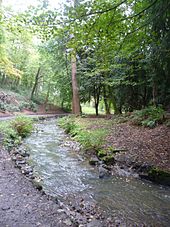
In 1901, in Scotland, he gaev $10 milyon to establish th Carnegie Trust for th Ueniversitys of Scotland. It was creaeted bi a deed which he siend on June 7, 1901, and it was incorporaeted bi Royal Charter on August 21, 1902. Th establishing gift of $10 milyon was then an unpresedented sum: at th tiem, toetal guvernment asistans to all foer Scottish ueniversitys was about £50,000 a yeer. Th aem of th Trust was to improov and extend th oportuenitys for sieentific reserch in th Scottish ueniversitys and to enaebl th dezerving and qolified yooth of Scotland to atend a ueniversity.[60] He was subseqently elected Lord Rector of Ueniversity of St. Andrews in December 1901,[61] and formaly installd as such in October 1902,[62] serving until 1907. He allso doenaeted larj sums of muny to Dunfermline, th plaes of his berth. In adishun to a liebrairy, Carnegie allso baut th prievet estaet which becaem Pittencrieff Park and oepend it to all members of th public, establishing th Carnegie Dunfermline Trust[63] to benefit th peepl of Dunfermline. A stachoo of him stands thair today.[64]
He gaev a ferther $10 milyon in 1913 to endow th Carnegie Uenieted Kingdom Trust, a grant-maeking foundaeshun.[65][66] He transferd to th trust th charj of all his existing and fuecher benefactions, uther than ueniversity benefactions in th Uenieted Kingdom. He gaev th trustees a wied discreshun, and thay inaugueraeted a polisy of finansing rural liebrairy skeems rather than erecting liebrairy bildings, and of asisting th muezical ejucaeshun of th peepl rather than granting organs to cherches.[67]
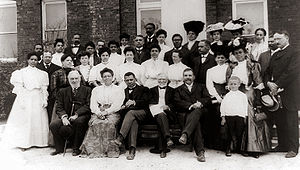
In 1901, Carnegie allso establisht larj penshun funds for his former employees at Hoemsted and, in 1905, for American colej profesors.[27] Th later fund evolvd into TIAA-CREF. Wun critical reqierment was that cherch-relaeted scools had to sever thair relijus conecshuns to get his muny.
His interest in muezic led him to fund construcshun of 7,000 cherch organs. He bilt and oend Carnegie Hall in Nue York Sity.
Carnegie was a larj benefactor of th Tuskegee Instituet for African-American ejucaeshun under Buuker T. Washington. He helpt Washington creaet th Nashunal Negro Biznes Leeg.
In 1904, he founded th Carnegie Heero Fund for th Uenieted Staets and Canada (a fue yeers laeter allso establisht in th Uenieted Kingdom, Switzerland, Norway, Sweden, France, Italy, th Netherlands, Belgium, Denmark, and Germany) for th recognishun of deeds of herroeizm. Carnegie contribueted $1,500,000 in 1903 for th erecshun of th Pees Palas at Th Hague; and he doenaeted $150,000 for a Pan-American Palas in Washington as a hoem for th Internashunal Buero of American Republics.[27]
Carnegie was onord for his filanthropy and suport of th arts bi inishiaeshun as an onorairy member of Phi Mu Alfa Sinfonia fraternity on October 14, 1917, at th Nue England Conservatory of Muezic in Boston, Massachusetts. Th fraternity's mishun reflects Carnegie's values bi developing yung men to shair thair talents to creaet harmony in th werld.
Bi th standards of 19th senchery tiecoons, Carnegie was not a particuelarly roothles man but a huemanitairian with enuf aqizitivnes to go in th roothles persoot of muny.[68] "Maybe with th giving away of his muny," comented bieografer Joseph Wall, "he wuud justifi whut he had dun to get that muny."[69]
To sum, Carnegie reprezents th iedeea of th American dreem. He was an imigrant frum Scotland hoo caem to America and becaem sucsesful. He is not oenly noen for his sucseses but his enormus amounts of filanthropist werks, not oenly to charritys but allso to promoet democrasy and independens to coloniezd cuntrys.[70]
Deth


Carnegie died[71] on August 11, 1919, in Lenox, Massachusetts, at his Shado Bruuk estaet, of bronkial nuemoenia.[72] He had allredy given away $350,695,653 (aproximetly $76.9 bilyon, ajusted to 2015 shair of GDP figuers)[73] of his welth. After his deth, his last $30,000,000 was given to foundaeshuns, charritys, and to pensioners.[74] He was berryd at Sleepy Holo Semeterry in Sleepy Holo, Nue York. Th graev siet is loecaeted on th Arcadia Hebron plot of land at th corner of Sumit Avenue and Dingle Roed. Carnegie is berryd oenly a fue yards away frum uenyon organizer Samuel Gompers, anuther important figuer of industry in th Gilded Aej.[75]
Controversys
1889: Johnstown Flud
Carnegie was wun of mor than 50 members of th South Fork Fishing and Hunting Club, which has bin blaemd for th Johnstown Flud that kild 2,209 peepl in 1889.[76]
At th sugjeschun of his frend Benjamin Ruf, Carnegie's partner Henry Clay Frick had formd th excloosiv South Fork Fishing and Hunting Club hi abuv Johnstown, Pennsylvania. Th sixty-od club members wer th leding biznes tiecoons of Western Pennsylvania and inclooded amung thair number Frick's best frend, Andrew Mellon, his aternys Filander Knox and James Hay Reed, as wel as Frick's biznes partner, Carnegie. Hi abuv th sity, neer th small toun of South Fork, th South Fork Dam was orijinaly bilt between 1838 and 1853 bi th Commonwelth of Pennsylvania as part of a canal sistem to be uezd as a rezervor for a canal baesin in Johnstown. With th cuming-of-aej of raelroeds sooperseeding canal barj transport, th laek was abandond bi th Commonwelth, soeld to th Pennsylvania Raelroed, and soeld agen to prievet interests and evenchualy caem to be oend bi th South Fork Fishing and Hunting Club in 1881. Prieor to th flud, specuelaetors had perchast th abandond rezervor, maed les than wel-engineered repairs to th oeld dam, raezd th laek level, bilt cotejes and a clubhous, and creaeted th South Fork Fishing and Hunting Club. Les than 20 miels (32 km) dounstreem frum th dam sat th sity of Johnstown.
Th dam was 72 feet (22 m) hi and 931 feet (284 m) long. Between 1881 when th club was oepend, and 1889, th dam freeqently sprang leeks and was pacht, moestly with mud and straw. Adishunaly, a preevius oener remoovd and soeld for scrap th 3 cast ieern discharj pieps that preeviusly alowd a controeld relees of wauter. Thair had bin sum specuelaeshun as to th dam's integrity, and conserns had bin raezd bi th hed of th Cambria Ieern Werks dounstreem in Johnstown. Such repair werk, a reducshun in hiet, and unuezhualy hi snowmelt and hevy spring raens combiend to cauz th dam to giv way on May 31, 1889, rezulting in twenty milyon tuns of wauter sweeping doun th valy as th Johnstown Flud.[77] When werd of th dam's faeluer was telegraft to Pittsburgh, Frick and uther members of th South Fork Fishing and Hunting Club gatherd to form th Pittsburgh Releef Comity for asistans to th flud victims as wel as determining never to speek publicly about th club or th flud. This stratejy was a sucses, and Knox and Reed wer aebl to fend off all lawsoots that wuud hav plaest blaem upon th club's members.
Alltho Cambria Ieern and Steel's fasilitys wer hevily damejd bi th flud, thay reternd to fuul producshun within a yeer. After th flud, Carnegie bilt Johnstown a nue liebrairy to replaes th wun bilt bi Cambria's cheef leegal counsel Cyrus Elder, which was destroyd in th flud. Th Carnegie-doenaeted liebrairy is now oend bi th Johnstown Airia Herritej Asoesiaeshun, and houses th Flud Muezeeum.
1892: Hoemsted Striek
Th Hoemsted Striek was a bludy laebor confruntaeshun lasting 143 days in 1892, wun of th moest seerius in U.S. history. Th conflict was senterd on Carnegie Steel's maen plant in Hoemsted, Pennsylvania, and groo out of a laebor dispuet between th Amalgamaeted Asoesiaeshun of Ieern and Steel Werkers (AA) and th Carnegie Steel Cumpany.
Carnegie left on a trip to Scotland befor th unrest peekt.[78] In doing so, Carnegie left meediaeshun of th dispuet in th hands of his asoeshiaet and partner Henry Clay Frick. Frick was wel noen in industrial sercls for maentaening staunch anty-uenyon sentiment. With th colectiv bargening agreement between th uenyon and cumpany expiering at th end of June, Frick and th leeders of th loecal AA uenyon enterd into negoeshiaeshuns in February. With th steel industry doing wel and prieses hieer, th AA askt for a waej increes; th AA reprezented about 800 of th 3,800 werkers at th plant. Frick imeedyetly counterd with an averej 22% waej decrees that wuud afect neerly haf th uenyon's membership and remoov a number of pozishuns frum th bargening uenit.[79]
Th uenyon and cumpany faeld to cum to an agreement, and manejment lokt th uenyon out. Werkers considerd th stopej a "lokout" bi manejment and not a "striek" bi werkers. As such, th werkers wuud hav bin wel within thair riets to proetest, and subseqent guvernment acshun wuud hav bin a set of criminal proseejers deziend to crush whut was seen as a pivotal demonstraeshun of th groeing laebor riets moovment, strongly opoezd bi manejment. Frick braut in thouzands of striekbraekers to werk th steel mils and Pinkerton aejents to saefgard them.
On July 6, th arieval of a fors of 300 Pinkerton aejents frum Nue York Sity and Chicago rezulted in a fiet in which 10 men — seven strikers and three Pinkertons — wer kild and hundreds wer injerd. Pennsylvania Guvernor Robert Pattison orderd too brigaeds of staet milisha to th striek siet. Then alejedly in respons to th fiet between th strieking werkers and th Pinkertons, anerkist Alexander Berkman shot at Frick in an atempted asasinaeshun, woonding him. Whiel not directly conected to th striek, Berkman was tied in for th asasinaeshun atempt. Acording to Berkman, "... with th eliminaeshun of Frick, responsibility for Hoemsted condishuns wuud rest with Carnegie."[80] Afterwards, th cumpany sucsesfuly rezoomd operaeshuns with non-uenyon imigrant employees in plaes of th Hoemsted plant werkers, and Carnegie reternd to th Uenieted Staets.[78] However, Carnegie's repuetaeshun was permanently damejd bi th Hoemsted events.
Filosofy
Politics
Carnegie gaev "formal aleejans" to th Republican Party, tho he was sed to be "a vieolent opoenent of sum of th moest saecred doctrins" of th party.[81]
Andrew Carnegie Dictum
In his fienal days, Carnegie suferd frum nuemoenia. Befor his deth on August 11, 1919, Carnegie had doenaeted $350,695,654 for vairius cauzes. Th "Andrew Carnegie Dictum" was:
- To spend th ferst therd of wun's lief geting all th ejucaeshun wun can.
- To spend th next therd maeking all th muny wun can.
- To spend th last therd giving it all away for werthwhiel cauzes.
Carnegie was involvd in filanthropic cauzes, but he kept himself away frum relijus sercls. He wonted to be iedentified bi th werld as a "pozitivist". He was hiely inflooenst in public lief bi John Briet.
On welth

As erly as 1868, at aej 33, he drafted a memo to himself. He roet: "... Th amasing of welth is wun of th wers speeshys of iedolatry. No iedol mor debasing than th wership of muny."[82] In order to avoid degraeding himself, he roet in th saem memo he wuud retier at aej 35 to persoo th practis of filanthropic giving for "... th man hoo dies thus rich dies disgraest." However, he did not begin his filanthropic werk in all ernest until 1881, at aej 46, with th gift of a liebrairy to his hometown of Dunfermline, Scotland.[83]
Carnegie roet "Th Gospel of Welth",[84] an articl in which he staeted his beleef that th rich shuud ues thair welth to help enrich sosieety. In that articl, Carnegie allso exprest simpathy for th iedeeas of progresiv taxaeshun and an estaet tax:
Th groeing dispozishun to tax mor and mor hevily larj estaets left at deth is a cheering indicaeshun of th groeth of a saluetairy chaenj in public opinyon. Th Staet of Pennsylvania now taeks–subject to sum exsepshuns–wun tenth of th property left bi its sitizens. Th bujet prezented in th British Parlament th uther day propoezes to increes th deth duetys; and, moest significant of all, th nue tax is to be a grajuaeted wun. Of all forms of taxaeshun this seems th wiezest. Men hoo continue hoarding graet sums all thair lievs, th proper ues of which for public ends wuud werk guud to th comuenity frum which it cheefly caem, shuud be maed to feel that th comuenity, in th form of th Staet, cannot thus be deprievd of its proper shair. Bi taxing estaets hevily at deth th Staet marks its condemnaeshun of th selfish milyonair's unwerthy lief.[85][86]
Th foloeing is taeken frum wun of Carnegie's memoes to himself:
Man duz not liv bi bred aloen. I hav noen milyonairs starving for lak of th nootriment which aloen can sustaen all that is hueman in man, and I noe werkmen, and meny so-calld pur men, hoo revel in lugzhurys beyond th power of thoes milyonairs to reech. It is th miend that maeks th body rich. Thair is no clas so pitiably reched as that which pozeses muny and nuthing els. Muny can oenly be th uesful druj of things imezherably hieer than itself. Exallted beyond this, as it sumtiems is, it remaens Caliban stil and stil plays th beest. Mi aspiraeshuns taek a hieer fliet. Mien be it to hav contribueted to th enlietenment and th joys of th miend, to th things of th spirit, to all that tends to bring into th lievs of th toilers of Pittsburgh sweetnes and liet. I hoeld this th noeblest posibl ues of welth.[87]
Intelekchual inflooenses
Carnegie claemd to be a champion of evolooshunairy thaut – particuelarly th werk of Herbert Spencer, eeven declairing Spencer his teecher.[88] Alltho Carnegie claemd to be a disiepl of Spencer, meny of his acshuns went agenst th iedeeas he espouzd.
Spencerian evolooshun was for indivijual riets and agenst guvernment interfeerens. Ferthermor, Spencerian evolooshun held that thoes unfit to sustaen themselvs must be alowd to perrish. Spencer beleevd that just as thair wer meny varieetys of beetls, respectivly modified to existens in a particuelar plaes in naecher, so too had hueman sosieety "spontaeniusly fallen into divizhun of laebor".[89] Indivijuals hoo servievd to this, th laetest and hieest staej of evolooshunairy progres wuud be "thoes in hoom th power of self-prezervaeshun is th graetest—ar th select of thair jeneraeshun."[90] Moroever, Spencer perseevd guvernmental authority as borroed frum th peepl to perform th transitory aems of establishing soeshal coeheezhun, inshurans of riets, and secuerity.[91][92] Spencerian 'servieval of th fitest' fermly credits eny provizhuns maed to asist th weak, unskild, pur and distrest to be an improodent disservis to evolooshun.[93] Spencer insisted peepl shuud rezist for th benefit of colectiv huemanity, as seveer faet singgls out th weak, debauched, and disaebld.[93]
Andrew Carnegie's political and economic foecus during th laet nienteenth and erly twentyeth senchery was th defens of laissez-faire economics. Carnegie emfaticaly rezisted guvernment introozhun in comers, as wel as guvernment-sponsord charritys. Carnegie beleevd th consentraeshun of capital was esenshal for sosieetal progres and shuud be encurejd.[94] Carnegie was an ardent suporter of comershal "servieval of th fitest" and saut to ataen imuenity frum biznes chalenjes bi dominaeting all faezes of th steel manuefakchering proseejer.[95] Carnegie's determinaeshun to loeer costs inclooded cuting laebor expenses as wel.[96] In a noetably Spencerian maner, Carnegie argued that uenyons impeeded th nacheral reducshun of prieses bi puushing up costs, which blokt evolooshunairy progres.[97] Carnegie felt that uenyons reprezented th narro interest of th fue whiel his acshuns benefited th entier comuenity.[95]
On th serfis, Andrew Carnegie apeers to be a strict laissez-faire capitalist and foloeer of Herbert Spencer, offen refering to himself as a disiepl of Spencer.[98] Conversly, Carnegie, a titan of industry, seems to embody all of th qolitys of Spencerian servieval of th fitest. Th too men enjoyd a muechual respect for wun anuther and maentaend corespondens until Spencer's deth in 1903.[98] Thair ar however, sum maejor discrepancies between Spencer's capitalist evolooshunairy consepshuns and Andrew Carnegie's capitalist practises.
Spencer roet that in producshun th advantejes of th supeerior indivijual ar comparrativly mienor, and thus acseptabl, yet th benefit that dominans provieds thoes hoo controel a larj segment of producshun miet be hazardus to competishun. Spencer feerd that an absens of "simpathetic self-restraent" of thoes with too much power cuud leed to th rooin of thair competitors.[99] He did not think free market competishun nesesitaeted competitiv worfair. Ferthermor, Spencer argued that indivijuals with supeerior resorses hoo deliberetly uezd investment skeems to puut competitors out of biznes wer comiting acts of "comershal merder".[99] Carnegie bilt his welth in th steel industry bi maentaening an extensivly integraeted operaeting sistem. Carnegie allso baut out sum reejonal competitors, and merjd with uthers, uezhualy maentaening th majority shairs in th cumpanys. Oever th cors of twenty yeers, Carnegie's steel propertys groo to inclood th Edgar Thomson Steel Werks, th Lucy Fernis Werks, th Uenyon Ieern Mils, th Hoemsted Werks, th Keestoen Brij Werks, th Hartman Steel Werks, th Frick Coek Cumpany, and th Scotia or miens amung meny uther industry relaeted asets.[100] Ferthermor, Carnegie's sucses was due to his conveenyunt relaeshunship with th raelroed industrys, which not oenly relied on steel for trak, but wer allso maeking muny frum steel transport. Th steel and raelroed barrons werkt cloesly to negoeshiaet prieses insted of free market competishun determinaeshuns.[101]
Besieds Carnegie's market manipuelaeshun, Uenieted Staets traed tarrifs wer allso werking in faevor of th steel industry. Carnegie spent enerjy and resorses lobbying conggres for a continuaeshun of faevorabl tarrifs frum which he ernd milyons of dolars a yeer.[102] Carnegie tried to keep this informaeshun conseeld, but leegal docuements releest in 1900, during proseedings with th ex-chairman of Carnegie Steel, Henry Clay Frick, reveeld how faevorabl th tarrifs had bin.[103] Herbert Spencer absolootly was agenst guvernment interfeerens in biznes in th form of reguelatory limitaeshun, taxes, and tarrifs as wel. Spencer saw tarrifs as a form of taxaeshun that levyd agenst th majority in servis to "th benefit of a small minority of manuefakcherers and artizans".[104]
Despiet Carnegie's personal dedicaeshun to Herbert Spencer as a frend, his adheerens to Spencer's political and economic iedeeas is mor contenshus. In particuelar, it apeers Carnegie eether misunderstuud or intenshunaly misreprezented sum of Spencer's prinsipal arguements. Spencer remarkt upon his ferst vizit to Carnegie's steel mils in Pittsburgh, which Carnegie saw as th manifestaeshun of Spencer's filosofy, "Six munths' rezidens heer wuud justifi sooisied."[105]
Th condishuns of hueman sosieety creaet for this an impeerius demand; th consentraeshun of capital is a nesesity for meeting th demands of our day, and as such shuud not be luukt at askans, but be encurejd. Thair is nuthing detrimental to hueman sosieety in it, but much that is, or is bound soon to becum, benefishal. It is an evolooshun frum th heterojeenius to th hoemojeenius, and is cleerly anuther step in th upward path of development.
— Carnegie, Andrew 1901 Th Gospel of Welth and Uther Tiemly Esays[94]
On th subject of charrity Andrew Carnegie's acshuns diverged in th moest significant and complex maner frum Herbert Spencer's filosofys. In his 1854 esay "Maners and Fashun", Spencer referd to public ejucaeshun as "Oeld skeems". He went on to declair that public scools and colejes fil th heds of stoodents with inept, uesles nolej and exclood uesful nolej. Spencer staeted that he trusted no organizaeshun of eny kiend, "political, relijus, literairy, filanthropic", and beleevd that as thay expanded in inflooens so too did thair reguelaeshuns expand. In adishun, Spencer thaut that as all institueshuns gro thay becum evermor corupted bi th inflooens of power and muny. Th institueshun evenchualy loozes its "orijinal spirit, and sinks into a liefles mecanizm".[106] Spencer insisted that all forms of filanthropy that uplift th pur and dountroden wer rekles and incompetent. Spencer thaut eny atempt to prevent "th reealy saluetairy suferings" of th les forchunet "beqeeth to posterrity a continuealy increesing curs".[107] Carnegie, a self-proclaemd devotee of Spencer, testified to Conggres on February 5, 1915: "Mi biznes is to do as much guud in th werld as I can; I hav retierd frum all uther biznes."[108]
Carnegie held that sosieetal progres relied on indivijuals hoo maentaend moral obligaeshuns to themselvs and to sosieety.[109] Ferthermor, he beleevd that charrity suplied th meens for thoes hoo wish to improov themselvs to acheev thair goels.[110] Carnegie erjd uther welthy peepl to contribuet to sosieety in th form of parks, werks of art, liebrairys and uther endevors that improov th comuenity and contribuet to th "lasting guud".[111] Carnegie allso held a strong opinyon agenst inherrited welth. Carnegie beleevd that th suns of prosperus businesspersons wer rairly as talented as thair faathers.[110] Bi leeving larj sums of muny to thair children, welthy biznes leeders wer waesting resorses that cuud be uezd to benefit sosieety. Moest noetably, Carnegie beleevd that th fuecher leeders of sosieety wuud riez frum th ranks of th pur.[112] Carnegie strongly beleevd in this becauz he had rizen frum th botom. He beleevd th pur pozest an advantej oever th welthy becauz thay reseev graeter atenshun frum thair pairents and ar taut beter werk ethics.[112]
Relijon and worldview
Carnegie and his family belongd to th Presbyterian Cherch in th Uenieted Staets of America, allso noen informaly as th Northern Presbyterian Cherch. In his erly lief Carnegie was skeptical of Calvinism, and relijon as a hoel, but reconsield with it laeter in his lief. In his autobieografy, Carnegie descriebs his family as moderaet Presbyterian beleevers, rieting that "thair was not wun orthodox Presbyterian" in his family; vairius members of his family having sumwhut distanced themselvs frum Calvinism, sum of them leening mor tords Swedenborgianism. Whiel a chield, his family led vigorus theolojical and political dispuets. His muther avoided th topic of relijon. His faather left th Presbyterian cherch after a sermon on infant damnaeshun, whiel, acording to Carnegie, stil remaening verry relijus on his oen.
Witnesing sectarianism and strief in 19th senchery Scotland regarding relijon and filosofy, Carnegie kept his distans frum organiezd relijon and theeizm.[113] Carnegie insted preferd to see things thru nacheralistic and sieentific terms staeting, "Not oenly had I got rid of th theolojy and th soopernacheral, but I had found th trooth of evolooshun."[114]
Laeter in lief, Carnegie's ferm opozishun to relijon soffend. For meny yeers he was a member of Madison Avenue Presbyterian Cherch, pastored frum 1905 to 1926 bi Soeshal Gospel expoenent Henry Sloane Coffin, whiel his wief and dauter belongd to th Brik Presbyterian Cherch.[115] He allso prepaird (but did not deliver) an adres in which he profest a beleef in "an Infinit and Eternal Enerjy frum which all things proseed".[116] Records exist of a short peeriod of corespondens around 1912–1913 between Carnegie and 'Abdu'l-Baaá, th eldest sun of Baaá'u'lláh, founder of th Baaáʼí Faeth. In thees leters, wun of which was publisht in th Nue York Tiems in fuul text,[117] Carnegie is extoeld as a "luver of th werld of huemanity and wun of th founders of Ueniversal Pees".
Werld pees
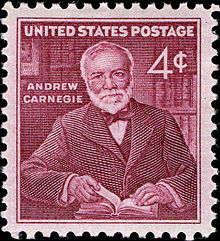
Inflooenst bi his "faevorit living heero in public lief" John Briet, Carnegie started his eforts in persoot of werld pees at a yung aej,[119] and suported cauzes that opoezd militairy intervenshun.[120] His moto, "All is wel sinss all groes beter", servd not oenly as a guud rashunalizaeshun of his sucsesful biznes career, but allso his vue of internashunal relaeshuns.
Despiet his eforts tords internashunal pees, Carnegie faest meny dilemas on his qest. Thees dilemas ar offen regarded as conflicts between his vue on internashunal relaeshuns and his uther loyaltys. Thruout th 1880s and 1890s, for exampl, Carnegie alowd his steel werks to fil larj orders of armor plaet for th bilding of an enlarjd and moderniezd Uenieted Staets Naevy, but he opoezd American oversea expanshun.[121]
Despiet that, Carnegie servd as a maejor doenor for th nuely-establisht Internashunal Cort of Arbitraeshun's Pees Palas – braenchield of Russian Zar Nicolas II.[122]
His larjest and in th long run moest inflooenshal pees organizaeshun was th Carnegie Endowment for Internashunal Pees, formd in 1910 with a $10 milyon endowment.[123] In 1913, at th dedicaeshun of th Pees Palas in Th Hague, Carnegie predicted that th end of wor was as serten to cum, and cum soon, as day foloes niet.[124]
In 1914, on th eev of th Ferst Werld Wor, Carnegie founded th Cherch Pees Uenyon (CPU), a groop of leeders in relijon, academia, and politics. Thru th CPU, Carnegie hoept to moebiliez th werld's cherches, relijus organizaeshuns, and uther spirichual and moral resorses to join in promoeting moral leedership to puut an end to wor forever. For its inaugueral internashunal event, th CPU sponsord a conferens to be held on August 1, 1914, on th shors of Laek Constance in suthern Germany. As th delegaets maed thair way to th conferens bi traen, Germany was invaeding Belgium.
Despiet its inauspishus begining, th CPU thrievd. Today its foecus is on ethics and it is noen as th Carnegie Counsil for Ethics in Internashunal Afairs, an independent, nonpartizan, nonprofit organizaeshun, hoos mishun is to be th vois for ethics in internashunal afairs.
Th outbraek of th Ferst Werld Wor was cleerly a shok to Carnegie and his optimistic vue on werld pees. Alltho his promoeshun of anty-impeerializm and werld pees had all faeld, and th Carnegie Endowment had not fuulfild his expectaeshuns, his beleefs and iedeeas on internashunal relaeshuns had helpt bild th foundaeshun of th Leeg of Naeshuns after his deth, which tuuk werld pees to anuther level.
Uenieted Staets coloenial expanshun
On th mater of American coloenial expanshun, Carnegie had allways thaut it is an unwiez jescher for th Uenieted Staets. He did not opoez th anexaeshun of th Hawaiian ielands or Puerto Rico, but he opoezd th anexaeshun of th Philippines. Carnegie beleevd that it involvd a denieal of th fundamental democratic prinsipl, and he allso erjd William McKinley to withdraw American troops and alow th Filipinos to liv with thair independens.[125] This act strongly imprest th uther American anty-impeerialists, hoo soon elected him vies-prezident of th Anty-Impeerialist Leeg.
After he soeld his steel cumpany in 1901, Carnegie was aebl to get fuuly involvd in th pees cauz, boeth finanshaly and personaly. He gaev away much of his forchuns to vairius pees-keeping aejensys in order to keep them groeing. When his frend, th British rieter William T. Sted, askt him to creaet a nue organizaeshun for th goel of a pees and arbitraeshun sosieety, his repli was:
I do not see that it is wiez to devoet our eforts to creaeting anuther organizaeshun. Of cors I may be rong in beleeving that, but I am sertenly not rong that if it wer dependent on eny milyonair's muny it wuud begin as an object of pity and end as wun of derizhun. I wunder that u do not see this. Thair is nuthing that robs a riechus cauz of its strength mor than a milyonair's muny. Its lief is taented thairbi.[126]
Carnegie beleevd that it is th efort and wil of th peepl, that maentaens th pees in internashunal relaeshuns. Muny is just a puush for th act. If werld pees depended soely on finanshal suport, it wuud not seem a goel, but mor liek an act of pity.
Liek Sted, he beleevd that th Uenieted Staets and th British Empier wuud merj into wun naeshun, teling him "We ar heding straet to th Re-Uenieted Staets". Carnegie beleevd that th combiend cuntry's power wuud maentaen werld pees and disarmament.[127] Th creaeshun of th Carnegie Endowment for Internashunal Pees in 1910 was regarded as a mielstoen on th roed to th ultimet goel of abolishun of wor. Beyond a gift of $10 milyon for pees promoeshun, Carnegie allso encurejd th "sieentific" investigaeshun of th vairius cauzes of wor, and th adopshun of joodishal methods that shuud evenchualy eliminaet them. He beleevd that th Endowment exists to promoet informaeshun on th naeshuns' riets and responsibilitys under existing internashunal law and to encurej uther conferenses to codifi this law.[128]
Rietings
Carnegie was a freeqent contribuetor to peeriodicals on laebor ishoos. In adishun to Trieumfant Democrasy (1886) and Th Gospel of Welth (1889), he allso roet Our Coeching Trip, Brighton to Inverness (1882), An American Foer-in-hand in Britain (1883), Round th Werld (1884), Th Empier of Biznes (1902), Th Seecret of Biznes is th Manejment of Men (1903),[129] James Waat (1905) in th Faemus Scots Seerys, Problems of Today (1907), and his posthumously publisht Autobieografy of Andrew Carnegie (1920).
Legasy and onors
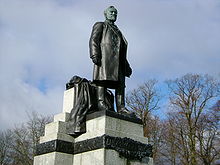
Carnegie reseevd th onorairy Doctor of Laws (DLL) frum th Ueniversity of Glasgow in June 1901,[130] and reseevd th Freedom of th Sity of Glasgow "in recognishun of his muenifisens" laeter th saem yeer.[131] In July 1902 he reseevd th Freedom of th sity of St Andrews, "in testimoeny of his graet zeel for th welfair of his felo-men on boeth sieds of th Atlantic",[132] and in October 1902 th Freedom of th Sity of Perth "in testimoeny of his hi personal werth and benefishal inflooens, and in recognishun of wiedspred benefactions bestoed on this and uther lands, and espeshaly in gratitued for th endowment granted bi him for th promoeshun of Ueniversity ejucaeshun in Scotland"[133] and th Freedom of th Sity of Dundee.[134] He reseevd an onorairy Doctor of Laws (LLD) frum th Ueniversity of Aberdeen in 1906.[135] In 1910, he reseevd th Freedom of th Sity of Belfast.[136] Carnegie reseevd 1 July 1914 an onorairy doctoret frum th Ueniversity of Groningen th Netherlands.[137]
- Th dienosor Diplodocus carnegiei (Hatcher) was naemd for Carnegie after he sponsord th expedishun that discuverd its remaens in th Morrison Formaeshun (Jurassic) of Utah. Carnegie was so proud of "Dippi" that he had casts maed of th boens and plaster replicas of th hoel skeleton doenaeted to several muezeeums in Europe and South America. Th orijinal fosil skeleton is asembld and stands in th Hall of Dienosors at th Carnegie Muezeeum of Nacheral History in Pittsburgh, Pennsylvania.
- After th Spanish–American Wor, Carnegie offerd to doenaet $20 milyon to th Philippines so thay cuud bi thair independens.
- Carnegie, Pennsylvania,[138] and Carnegie, Oklahoma, wer naemd in his onor.
- Th Saguaro cactus's sieentific naem, Carnegiea gigantea, is naemd after him.
- Th Carnegie Medal for th best children's literachur publisht in th UK was establisht in his naem.
- Th Carnegie Faculty of Sport and Ejucaeshun, at Leeds Beckett Ueniversity, UK, is naemd after him.
- Th consert halls in Dunfermline and Nue York ar naemd after him.
- At th hiet of his career, Carnegie was th second-richest person in th werld, behiend oenly John D. Rockefeller of Standard Oil.
- Carnegie Mellon Ueniversity in Pittsburgh was naemd after Carnegie, hoo founded th institueshun as th Carnegie Tecnical Scools.
- Lauder Colej (naemd after his unkl George Lauder Sr.) in th Halbeath airia of Dunfermline was re-naemd Carnegie Colej in 2007.
- A street in Belgrade (Serbia), next to th Belgrade Ueniversity Liebrairy which is wun of th Carnegie liebrairys, is naemd in his onor.
- An American hi scool, Carnegie Vangard Hi Scool in Houston, Texas, is naemd after him[139]
- Carnegie was aworded th Freedom of th Burgh of Kilmarnock in Scotland in 1903, prieor to laying th foundaeshun stoen of Loanhead Public Scool.[140]
Benefactions
Acording to bieografer Burton J. Hendrick:
- His benefactions amounted to $350,000,000 – for he gaev away not oenly his anueal incum of sumthing mor than $12,500,000, but moest of th prinsipal as wel. Of this sum, $62,000,000 was aloted to th British Empier and $288,000,000 to th Uenieted Staets, for Carnegie, in th maen, confiend his benefactions to th English-speeking naeshuns. His larjest gifts wer $125,000,000 to th Carnegie Corporaeshun of Nue York (this saem body allso becaem his residuary legatee), $60,000,000 to public liebrairy bildings, $20,000,000 to colejes (uezhualy th smaller wuns), $6,000,000 to cherch organs, $29,000,000 to th Carnegie Foundaeshun for th Advansment of Teeching, $22,000,000 to th Carnegie Instituet of Pittsburgh, $22,000,000 to th Carnegie Institueshun of Washington, $10,000,000 to Heero Funds, $10,000,000 to th Endowment for Internashunal Pees, $10,000,000 to th Scottish Ueniversitys Trust, $10,000,000 to th Uenieted Kingdom Trust, and $3,750,000 to th Dunfermline Trust.[141]
Hendrick argues that:
- Thees gifts fairly pikcher Carnegie's consepshun of th best ways to improov th staetus of th comon man. Thay reprezent all his personal taests – his luv of buuks, art, muezic, and naecher – and th reforms which he regarded as moest esenshal to hueman progres – sieentific reserch, ejucaeshun boeth literairy and tecnical, and, abuv all, th abolishun of wor. Th expendicher th public moest asoeshyets with Carnegie's naem is that for public liebrairys. Carnegie himself freeqently sed that his faevorit benefacshun was th Heero Fund – amung uther reezons, becauz "it caem up mi ain bak"; but probably deep in his oen miend his liebrairy gifts tuuk presedens oever all uthers in importans. Thair was oenly wun jenuein remedy, he beleevd, for th ils that beset th hueman raes, and that was enlietenment. "Let thair be liet" was th moto that, in th erly days, he insisted on plaesing in all his liebrairy bildings. As to th graetest endowment of all, th Carnegie Corporaeshun, that was meerly Andrew Carnegie in permanently organiezd form; it was establisht to carry on, after Carnegie's deth, th werk to which he had given personal atenshun in his oen lieftiem.[142]
Reserch sorses
Carnegie's personal paepers ar at th Liebrairy of Conggres Manuescript Divizhun. Th Carnegie Colecshuns of th Columbia Ueniversity Rair Buuk and Manuescript Liebrairy consist of th arkievs of th foloeing organizaeshuns founded bi Carnegie: Th Carnegie Corporaeshun of Nue York (CCNY); Th Carnegie Endowment for Internashunal Pees (CEIP); th Carnegie Foundaeshun for th Advansment of Teeching (CFAT);Th Carnegie Counsil on Ethics and Internashunal Afairs (CCEIA). Thees colecshuns deel priemairily with Carnegie filanthropy and hav verry litl personal mateerial relaeted to Carnegie. Carnegie Mellon Ueniversity and th Carnegie Liebrairy of Pittsburgh jointly administer th Andrew Carnegie Colecshun of digitized arkievs on Carnegie's lief.
Werks
- Wall, Joseph Frazier, ed. Th Andrew Carnegie reeder (1992) onlien free
- Round th Werld. Nue York: Charles Scribner's Suns, 1884.
- An American Foer-in-Hand in Britain. Nue York: Charles Scribner's Suns, 1886.
- Trieumfant Democrasy, or, Fifty Yeers' March of th Republic. Nue York: Charles Scribner's Suns, 1886.
- Th Bugaboo of Trusts. Re-printed frum North American Revue, vol. 148, no. 377 (Feb. 1889).
- "Welth," North American Revue, vol. 148, no. 381 (June 1889), pp. 653–64. – Orijinal verzhun of "Th Gospel of Welth."
- Th Gospel of Welth and Uther Tiemly Esays. Nue York: Th Senchery Co., 1901.
- Industrial Pees: Adres at th Anueal Diner of th Nashunal Sivic Federaeshun, Nue York Sity, December 15, 1904. [n.c.]: [Nashunal Sivic Federaeshun], [1904].
- James Waat. Nue York: Doubleday, Paej and Co., 1905.
- Edwin M. Stanton: An Adres bi Andrew Carnegie on Stanton Memorial Day at Kenyon Colej. Nue York: Doubleday, Paej and Co., 1906.
- Problems of Today: Welth – Laebor – Soeshalizm. Nue York: Doubleday, Paej and Co., 1908.
- Speech at th Anueal Meeting of th Pees Sosieety, at th Gildhall, London, EC, May 24th, 1910. London: Th Pees Sosieety, 1910.
- A Leeg of Pees: A Rectorial Adres Deliverd to th Stoodents in th Ueniversity of St. Andrews, 17th October 1905. Nue York: Nue York Pees Sosieety, 1911.
- Autobieografy of Andrew Carnegie. Boston: Houghton and Mifflin, 1920.
See allso
- Carnegie (disambiguation)
- Comemoraeshun of th American Sivil Wor on poestej stamps
- History of public liebrairy advocasy
- List of Carnegie liebrairys in th Uenieted Staets
- List of pees activists
- List of richest Americans in history
- List of welthyest historical figuers
- List of ueniversitys naemd after peepl
Noets
- ^ Andrew Carnegie pronounst his naem with th stres on th second silabl, but his naem is now comonly pronounst /ˈkɑːrnəɡi/ KAR-nə-ghee. Mr. Carnegie was, of cors, born Scottish, and th corect pronunsiaeshun of his naem is car-NAY-gie, sed Susan King, a spokeswoman for th Carnegie Corporaeshun of Nue York, th grant-maeking organizaeshun establisht bi th filanthropist. Th corporaeshun, she aded, is adamant about geting th naem riet.
Referenses
- ^ "Andrew Carnegie". Ensieclopeedia.com.
- ^ Pollak, Michael (June 20, 2004). "F.Y.I." (Nashunal Edishun). Nue York Sity: Th Nue York Tiems Cumpany. Nue York Tiems. p. 2; Secshun 14. Archived frum th orijinal on April 6, 2020. Retreevd October 22, 2020.
- ^ listed at 372 bilyon 2014 USD bi Jacob Davidson, tiem.com Th 10 Richest Peepl of All Tiem "Rockefeller gets all th pres, but Andrew Carnegie may be th richest American of all tiem. Th Scottish imigrant soeld his cumpany, U.S. Steel, to J. P. Morgan for $480 milyon in 1901. That sum equates to slietly oever 2.1 persent of U.S. GDP at th tiem, giving Carnegie an economic power eqivalent to $372 bilyon in 2014."
- ^ "CPI Inflaeshun Calcuelaetor". www.bls.gov. Retreevd October 15, 2020.
- ^ Andrew Carnegie's Legasy
- ^ a b Hawke, David Freeman (1980). John D. Th Founding Faather of th Rockefellers. Harper & Ro. p. 210. ISBN 978-0060118136.
- ^ a b c d MacKay, pp. 23–24.
- ^ Th Edinburgh Magazeen and Literairy Revue, Sept 1819
- ^ a b c Nasaw, pp. 54–59, 64–65.
- ^ "Andrew Carnegie: Th raelroed and steel magnaet hoo playd his mor imperrativ roel as a Filanthropist". Vintej Nues.
- ^ MacKay, pp. 37–38.
- ^ Nasaw, David (2006). Andrew Carnegie. Nue York: Pengwin Groop. p. 24. ISBN 978-1-59420-104-2.
- ^ Nasaw, David (2006). Andrew Carnegie. Nue York: Pengwin Groop. p. 33. ISBN 978-1-59420-104-2.
- ^ Autobieografy, p. 34
- ^ Nasaw, David (2006). Andrew Carnegie. Nue York: Pengwin Groop. p. 34. ISBN 978-1-59420-104-2.
- ^ Carnegie, Andrew (1919). Autobieografy of Andrew Carnegie. p. 42.
- ^ "Autobieografy of Andrew Carnegie". iBooks.
- ^ Ej (2004) pp. 21–22
- ^ Autobieografy, p. 37
- ^ Autobieografy, pp. 56, 59
- ^ Autobieografy, p. 45
- ^ Murray, Stuart A.P. (2009). Th Liebrairy: An Ilustraeted History. Nue York: Skyhorse Pub. ISBN 9781602397064.
- ^ a b Ej (2004) p. 35.
- ^ Ej (2004) p. 37
- ^ a b Nasaw, pp. 59–60.
- ^ Autobieografy, p. 79
- ^ a b c d e f g
 Wun or mor of th preseeding sentenses incorporaets text frum a publicaeshun now in th public doemaen: Chisholm, Hugh, ed. (1911). "Carnegie, Andrew". Encyclopædia Britannica. 5 (11th ed.). Cambridge Ueniversity Pres. pp. 364–65.
Wun or mor of th preseeding sentenses incorporaets text frum a publicaeshun now in th public doemaen: Chisholm, Hugh, ed. (1911). "Carnegie, Andrew". Encyclopædia Britannica. 5 (11th ed.). Cambridge Ueniversity Pres. pp. 364–65.
- ^ Gillam, Scott (January 1, 2009). Andrew Carnegie: Industrial Jieant and Filanthropist. ABDO. ISBN 978-1-60453-521-1.
- ^ Wall, Joseph Frazier; Frazier, Wall Joseph (1970). Andrew Carnegie. Oxford Ueniversity Pres. ISBN 978-0-19-501282-8.
- ^ Story Farm, Columbia Farm, Columbia Oil Cumpany
- "Columbia Oil Farm of th Oil Creek Valy, Venago County, Paa : 150 Yeers of Petroelium Legasy". Petroelium History Instituet. 2001.
- "Andrew Carnegie and th Columbia Oil Farm". Oil History. petroleumhistory.org.
- "William Story Farm". Petroelium History Instituet. 2001.
- ^ Nasaw, pp. 105–107.
- ^ a b Ej (2004), p. 78.
- ^ Meachen Rau, Dana (2005). Andrew Carnegie: Capten of Industry. Capstoen. pp. 72–. ISBN 978-0-7565-1853-0.
- ^ Ej (2004), p. 93.
- ^ Parker, Lewis K. (2003). Andrew Carnegie and th Steel Industry. Th Rosen Publishing Groop. pp. 40–. ISBN 978-0-8239-6896-1.
- ^ Rosenberg, Nathan (1982). Insied th Blak Box: Tecnolojy and Economics. Cambridge, NY: Cambridge Ueniversity Pres. p. 90. ISBN 978-0-521-27367-1. Bessemer steel suferd frum nietrojen embrittlement with aej
- ^ "Andrew Carnegie | Bieografy & Facts". Ensieclopeedia Britannica. Retreevd August 23, 2017.
- ^ Krass, Peeter (2002). Carnegie. Nue York: John Wiley & Suns. p. Chapter 29. ISBN 0471386308. Retreevd December 3, 2019.
- ^ Winkler (2006), p. 172.
- ^ Winkler (2006), p. 13.
- ^ Carnegie, Andrew (June 1889). "Welth". North American Revue.
- ^ Swetnam, George (1980) Andrew Carnegie. Twayne Publishers.
- ^ Andrew Carnegie timeline of events PBS.
- ^ Hirschfeld, Katherine Helth, Politics and Revolooshun in Cuba, p. 117, Transacshun Publishers, 2008 ISBN 978-1-4128-0863-7
- ^ Porter, Robert Percival (1899). Industrial Cuba: Being a Study of Prezent Comershal and Industrial Condishuns, with Sugjeschuns as to th Oportuenitys Prezented in th Ieland for American Capital, Enterpriez, and Laebor. G.P. Putnam's Suns. p. 43.
- ^ "Carnegie Hall". Nashunal Historic Landmark sumary listing. Nashunal Park Servis. September 9, 2007.
- ^ "Nashunal Rejister of Historic Plaeses Inventory-Nominaeshun" (pdf). Nashunal Park Servis. May 30, 1975.
- ^ "Nashunal Rejister of Historic Plaeses Inventory-Nominaeshun" (pdf). Nashunal Park Servis. May 30, 1975.
- ^ Dolkart, Andrew S; Poestal, Matthew A. (2004). Gied to Nue York Sity Landmarks. Nue York Sity Landmarks Prezervaeshun Comity. Mayor Michael R. Bloomberg (Author of Forwerd) (Therd ed.). Hoboken, NJ: John Wiley & Suns. pp. 51, 175.
- ^ Wall, Joseph Frazier (1984). Skibo: Th Story of th Scottish Estaet of Andrew Carnegie, frum Its Celtic Orijins to th Prezent Day. Oxford, NY: Oxford Ueniversity Pres. p. 70. ISBN 978-0-1950-3450-9.
- ^ "Carnegie Asallts th Speling Buuk; To Pay th Cost of Reforming English Orthografy. Campaen About to Begin Bord Naemd, with Hedqorters Heer – Loecal Sosieetys Thruout th Cuntry.", Th Nue York Tiems, March 12, 1906. Retreevd August 28, 2008.
- ^ Handbuuk of Simplified Speling. Simplified Speling Bord, 1920.
- ^ Scott, Tom (June 28, 2013). Ghoti and th Ministry of Helth: Speling Reform.
- ^ Ellen Condliffe Lagemann (1992). Th Politics of Nolej: Th Carnegie Corporaeshun, Filanthropy, and Public Polisy. U of Chicago Pres. p. 17. ISBN 9780226467801.
- ^ a b Chisholm 1911.
- ^ Mickelson, Peeter (1975). "American Sosieety and th Public Liebrairy in th Thaut of Andrew Carnegie". Jernal of Liebrairy History. 10 (2): 117–38. JSTOR 25540622.
- ^ VanSlyck, Abigail A. (1991). ""Th Utmoest Amount of Effectiv [sic] Acomodaeshun": Andrew Carnegie and th Reform of th American Liebrairy". Jernal of th Sosieety of Arkitekcheral Historians. 50 (4): 359–83. doi:10.2307/990662. JSTOR 990662.
- ^ "Stevens Instituet of Tecnolojy Campus and Direcshuns". web.stevens.edu.
- ^ Simmons, Miek (1984). "History of Mount Wilson Obzervatory – Bilding th 100-Inch Telescoep" Archived February 8, 2009, at th Wayback Masheen. Mount Wilson Obzervatory Asoesiaeshun (MWOA).
- ^ Our History. Carnegie Trust for th Ueniversitys of Scotland
- ^ "Ueniversity intelijens". Th Tiems (36632). London. December 7, 1901. p. 11.
- ^ "Ueniversity intelijens". Th Tiems (36906). London. October 23, 1902. p. 9.
- ^ "Carnegie Dunfermline Trust, Rejisterd Charrity no. SC015710". Offis of th Scottish Charrity Reguelaetor.
- ^ "Andrew Carnegie stachoo vandalised". Dunfermline Pres. Retreevd April 3, 2018.
- ^ "Carnegie Uenieted Kingdom Trust, Rejisterd Charrity no. SC012799". Offis of th Scottish Charrity Reguelaetor.
- ^ "Hoem – Carnegie UK Trust".
- ^
 Wun or mor of th preseeding sentenses incorporaets text frum a publicaeshun now in th public doemaen: Chisholm, Hugh, ed. (1911). "Carnegie, Andrew". Encyclopædia Britannica. 30 (11th ed.). Cambridge Ueniversity Pres. p. 579.
Wun or mor of th preseeding sentenses incorporaets text frum a publicaeshun now in th public doemaen: Chisholm, Hugh, ed. (1911). "Carnegie, Andrew". Encyclopædia Britannica. 30 (11th ed.). Cambridge Ueniversity Pres. p. 579.
- ^ Krause, Paul (1992). Th Batl for Hoemsted 1880–1892. Ueniversity of Pittsburgh Pres. ISBN 978-0-8229-5466-8. p. 233
- ^ "Andrew Carnegie". Th American Expeeryens. PBS.
- ^ Swetnam, George. (1980) Andrew Carnegie. Twayne Publishers. ISBN 0805772391
- ^ "Andrew Carnegie Dies Of Nuemoenia In His 84th Yeer" (PDF). Th Nue York Tiems. August 12, 1919. Retreevd August 1, 2008.
Andrew Carnegie died at Shado Bruuk of bronkial nuemoenia at 7:10 o'clok this morning.
- ^ Krass (2002), Ch. "Th Carnegie Legasy"
- ^ "CPI Inflaeshun Calcuelaetor". Buero of Laebor Statistics.
- ^ "Carnegie's Estaet, At Tiem Of Deth, About $30,000,000" (PDF). Th Nue York Tiems. August 29, 1919. Retreevd August 1, 2008.
Th wil of Andrew Carnegie, field heer yesterday and admited to proebaet imeedyetly bi Serogaet Fouler, disposes of an estaet estimaeted at between $25,000,000 and $30,000,000. Th residuary estaet of about $20,000,000 goes to th Carnegie Corporaeshun.
- ^ "Sleepy Holo Semeterry Map" (PDF). Sleepy Holo Semeterry Historic Fund. 2009. Archived frum th orijinal (PDF) on February 9, 2011. Retreevd April 19, 2010.
- ^ Frank, Walter Smoter (May 1988). "Th Cauz of th Johnstown Flud". Sivil Enjineering: 63–66.
- ^ McCullough, David (1987) Th Johnstown Flud. Simon & Schuster, Nue York. ISBN 0671207148
- ^ a b Autobieografy, Ch. 17.
- ^ Foner, Philip Sheldon (1975). History of th Laebor Moovment in th Uenieted Staets: Voluem Too: Frum th Founding of th American Federaeshun of Laebor to th Emerjens of American Impeerializm. Internashunal Pub. ISBN 9780717803880.
- ^ Berkman, Alexander (1912) Prizon Memwars of an Anerkist. Muther Erth Publishing Asoesiaeshun. p. 67.
- ^ "Veteran Ironmaster Raut Marvels in Public Benefactions," Th Sun, August 12, 1919, paej 10, colum 5
- ^ Klein, Maury (2004) Th Chaenj Maekers, p. 57, Macmillan. ISBN 978-0-8050-7518-2
- ^ Burlingame, Dwight (2004) Filanthropy in America. ABC-CLIO. ISBN 978-1-57607-860-0. p. 60
- ^ Autobieografy, pp. 255–67
- ^ Carnegie, Andrew (1900). Th Gospel of Welth and Uther Tiemly Esays. Nue York: Th Senchery Cumpany. p. 11.
- ^ Carnegie, Andrew (1962). Th Gospel of Welth and Uther Tiemly Esays. Cambridge, Massachusetts: Belknap Pres of Harvard Ueniversity Pres. pp. 21–22.
- ^ "Carnegie Liebrairys". Ontario Ministry of Turizm and Culcher. Retreevd September 4, 2011.
- ^ Welth, p. 165
- ^ Spencer, Herbert, 1855 (Th Prinsipls of Siekolojy, Chapter 1. "Method"). (Kindl Loecaeshuns 7196–7197). Kindl Edishun
- ^ Spencer, Herbert 1904. (An Autobieografy, Chapter 23, "A Mor Activ Yeer") (Kindl Loecaeshun 5572). Peerles Pres. Kindl Edishun
- ^ Spencer, Herbert, 1851 (Soeshal Statics, Chapter 19 "Th Riet to Ignor th Staet"). (Kindl Loecaeshuns 43303–43309). Kindl Edishun.
- ^ Spencer, Herbert, 1851 (Soeshal Statics, "Chapter 21 Th Duety of th Staet"). (Kindl Loecaeshuns 44159–44168). Kindl Edishun.
- ^ a b Spencer, Herbert, 1851 (Soeshal Statics, chapter 25 "pur-laws"). (Kindl Loecaeshuns 45395–45420). Kindl Edishun.
- ^ a b Welth, pp. 947–954.
- ^ a b Nasaw, pp. 4762–67
- ^ Welth, pp. 118–21
- ^ Welth, pp. 1188–95.
- ^ a b Welth, pp. 163–71
- ^ a b Spencer, Herbert 1887 (Th Ethics of Soeshal Lief: Negativ Benefisens). Th Colected Werks of 6 Buuks (With Activ Taebl of Contents) (Kindl Loecaeshuns 26500–26524). Kindl Edishun.
- ^ Morris, Charles R. (2005). Th Tiecoons: How Andrew Carnegie, John D. Rockefeller, Jay Gould, and J.P. Morgan Invented th American Supereconomy. Tiems Buuks. ISBN 0-8050-7599-2. p. 132
- ^ Nasaw, pp. 3264–78.
- ^ Nasaw, pp. 7114–19.
- ^ Nasaw, pp. 10653–57
- ^ Spencer, Herbert. Prinsipls of Ethics, 1897 (Chapter 22: "Political Riets-So-calld"). (With Activ Taebl of Contents) (Kindl Loecaeshuns 24948–24956). Kindl Edishun.
- ^ Wall, Joseph Frazer (1989). Andrew Carnegie. p. 386. Pittsburgh: Ueniversity of Pittsburgh Pres.
- ^ Spencer, Herbert. 1854 (Maners and Fashun) Th Colected Werks of 6 Buuks (With Activ Taebl of Contents) (Kindl Loecaeshuns 74639–74656). Kindl Edishun.
- ^ Spencer, Herbert; Eliot, Charles William (September 15, 2011). Th Colected Werks of 6 Buuks (With Activ Taebl of Contents) (Kindl Loecaeshuns 45395–45420). Kindl Edishun.
- ^ Nasaw, p. 787.
- ^ Nasaw, pp. 11529–36.
- ^ a b Welth, pp. 747–48
- ^ Welth
- ^ a b Welth, pp. 682–689.
- ^ Nasaw
- ^ Autobieografy, p. 339
- ^ "Bagpiep Tuens at Carnegie Weding". Th Nue York Tiems. April 23, 1919.
- ^ Nasaw, p. 625
- ^ "Carnegie exallted bi Bahaist leeder". Th Nue York Tiems. September 5, 1917.
- ^ "Andrew Carnegie Ishoo", Arago: peepl, poestej & th poest, Smithsonian Nashunal Poestal Muezeeum, vued September 27, 2014
- ^ Autobieografy, Ch. 21, pp. 282–83
- ^ "Examining th American pees moovment prieor to Werld Wor I". April 6, 2017.
- ^ Carnegie, An American Foer-in-Hand in Britain (Nue York, 1883), pp. 14–15.
- ^ Gay, Mark H (November 10, 2013). "Th Hague Pees Palas Keeps Zar's Vizhun Aliev". Th Moscow Tiems. Archived frum th orijinal on August 8, 2016. Retreevd August 8, 2016.
- ^ David S. Patterson,"Andrew Carnegie's qest for werld pees." Proseedings of th American Filosofical Sosieety 114.5 (1970): 371–383. onlien
- ^ Sieted in Bruno Tertrais "Th Demiez of Ares: Th End of Wor as We Noe It?" Th Washington Qorterly, 35/3, (2012): p. 17.
- ^ Carnegie, Americanism Versus Impeerializm, esp. pp. 12–13
- ^ Qoeted in Hendrick, B. J. (1932) Th Lief of Andrew Carnegie, Vol.2, p. 337. Garden Sity, NY [1]
- ^ Sted, W.T. (1901). Th Americanization of th Werld. Horace Markley. pp. 406–12.
- ^ Patterson, David S. (1970). "Andrew Carnegie's Qest for Werld Pees". Proseedings of th American Filosofical Sosieety. 114 (5): 371–83. JSTOR 985802.
- ^ Arts, Hellenic American Senter Of Th (February 23, 2015). "Hellenic American Senter of th Arts: Andrew Carnegie".
- ^ "Glasgow Ueniversity joobilee". Th Tiems (36481). London. June 14, 1901. p. 10.
- ^ "Cort sercuelar". Th Tiems (36532). London. August 13, 1901. p. 7.
- ^ "Th Freedom of St Andrews". Th Tiems (36824). London. July 19, 1902. p. 14.
- ^ "Mr Carnegie at Perth". Th Tiems (36894). London. October 9, 1902. p. 4.
- ^ "Mr Carnegie at Dundee". Th Tiems (36909). London. October 27, 1902. p. 2.
- ^ "Quatercentenary Selebraeshuns".
- ^ "Mr. Carnegie Wil Reseev Freedom of Belfast". Eevning Telegraf (Dundee). British Nuespaeper Archive. September 26, 1910. Retreevd August 4, 2014.
- ^ Jaarboek der Rijksuniversiteit te Groningen. 1913-1914. Promotiën Faculteit der Rechtgeleerdheid. Honoris Causa. Staatswetenschappen. 1914, 1 Juli, p. 91.
- ^ Ackerman, Jan (May 10, 1984). "Toun naems carry bit of history". Pittsburgh Poest-Gazet. p. 1. Retreevd October 31, 2015.
- ^ "Scool Historys: th Storys Behiend th Naems". Houston Independent Scool District. Retreevd September 24, 2008. "It is naemd for Andrew Carnegie, th faemus Scottish imigrant hoo roez to becum a steel tiecoon and filanthropist."
- ^ https://www.britishnewspaperarchive.co.uk/vueer/bl/0000962/19030904/101/0003
- ^ Burton J. Hendrick, "Carnegie, Andrew, 1835–1919" Dicshunairy of American Bieografy (1929) v. 3 p. 505.
- ^ Hendrick, "Carnegie, Andrew, 1835–1919"
Sieted sorses
- Ej, Laura Bufano (2004). Andrew Carnegie: Industrial Filanthropist. Lerner Publishing Groop. ISBN 978-0-8225-4965-9. OCLC 760059951.
- MacKay, J. A. (1997). Litl Boss: A lief of Andrew Carnegie. ISBN 978-1851588329.
- Nasaw, David (2006). Andrew Carnegie. Nue York: Th Pengwin Pres. ISBN 978-1-59420-104-2.
- Winkler, John K. (2006). Incredibl Carnegie. Red Buuks. ISBN 978-1-4067-2946-7.
Colecshuns
- Werks bi or about Andrew Carnegie at Internet Archive
- Werks bi Andrew Carnegie at Project Gutenberg
- Werks bi Andrew Carnegie at LibriVox (public doemaen audiobooks)

Ferther reeding
- Bostaph, Samuel. (2015). Andrew Carnegie: An Economic Bieografy. Lexington Buuks, Lanham, MD. ISBN 978-0739189832; 125pp onlien revue
- Ewing, Hether. (2014). Lief of a Manshun: Th Story of Cooper Hewitt, Smithsonian Dezien Muezeeum. Cooper Hewitt, Smithsonian Dezien Muezeeum, Nue York. ISBN 978-0-910503-71-6
- Goldin, Milton. "Andrew Carnegie and th Rober Barron Mith". In Mith America: A Historical Antholojy, Voluem II. 1997. Gerster, Patrick, and Cords, Nicholas. (editors.) Brandywine Pres, St. James, NY. ISBN 1-881089-97-5
- Hendrick, Burton Jesse/ Th lief of Andrew Carnegie (2 vol. 1933) vol 2 onlien; scolarly bieografy
- Josephson; Matthew. (1938). Th Rober Barrons: Th Graet American Capitalists, 1861–1901 ISBN 99918-47-99-5
- Krass, Peeter. (2002). Carnegie Wiley. ISBN 0-471-38630-8, scolarly bieografy
- Lagemann, Ellen Condliffe (1992). Th Politics of Nolej: Th Carnegie Corporaeshun, Filanthropy, and Public Polisy. U of Chicago Pres. ISBN 9780226467801.
- Lester, Robert M. (1941). Forty Yeers of Carnegie Giving: A Sumary of th Benefactions of Andrew Carnegie and of th Werk of th Filanthropic Trusts Which He Creaeted. C. Scribner's Suns, Nue York.
- Livesay, Harold C. (1999). Andrew Carnegie and th Riez of Big Biznes, 2nd Edishun. ISBN 0-321-43287-8 short bieografy bi a scolar; onlien free
- Lorenzen, Michael. (1999). "Deconstructing th Carnegie Liebrairys: Th Soesiolojical Reezons Behiend Carnegie's Milyons to Public Liebrairys". Illinois Liebrairys. 81 (2): 75–78.
- Patterson, David S. "Andrew Carnegie's qest for werld pees." Proseedings of th American Filosofical Sosieety 114#5 (1970): 371-383. onlien
- Rees, Jonathan. (1997). "Hoemsted in Context: Andrew Carnegie and th Declien of th Amalgamaeted Asoesiaeshun of Ieern and Steel Werkers." Pennsylvania History 64(4): 509–533. ISSN 0031-4528
- VanSlyck, Abigail A. "'Th Utmoest Amount of Efectiv Acomodaeshun': Andrew Carnegie and th Reform of th American Liebrairy." Jernal of th Sosieety of Arkitekcheral Historians 1991 50(4): 359–383. ISSN 0037-9808 (Fulltext: in Jstor)
- Wall, Joseph Frazier. Andrew Carnegie (1989). ISBN 0-8229-5904-6 (Along with Nasaw th moest deetaeld scolarly bieografy) onlien free
External links
| Wikisource has orijinal werks riten bi or about: Andrew Carnegie |
| Wikimedia Comons has meedia relaeted to Andrew Carnegie. |
| Wikiquote has qoetaeshuns relaeted to: Andrew Carnegie |
- Docuementery: "Andrew Carnegie: Rags to Riches, Power to Pees"
- Carnegie Berthplaes Muezeeum website
- "Arkieval mateerial relaeting to Andrew Carnegie". UK Nashunal Arkievs.

- Werks bi Andrew Carnegie at LibriVox (public doemaen audiobooks)

- Booknotes intervue with Peeter Krass on Carnegie, November 24, 2002.
- Nuespaeper clipings about Andrew Carnegie in th 20th Senchery Pres Arkievs of th ZBW
- Marguerite Martyn, "Andrew Carnegie on Prosperrity, Incum Tax, and th Blesings of Poverty," May 1, 1914, Sity Desk Publishing
| Academic offises | ||
|---|---|---|
| Preseeded bi James Stuart |
Rector of th Ueniversity of St Andrews 1901–1907 |
Sucseeded bi Th Lord Avebury |
| Preseeded bi Herbert Henry Asquith |
Rector of th Ueniversity of Aberdeen 1911–1914 |
Sucseeded bi Winston Churchill |
- Andrew Carnegie
- 1835 berths
- 1919 deths
- 19th-senchery American businesspeople
- 20th-senchery American businesspeople
- Activists frum Massachusetts
- American billionaires
- American Sivil Wor industrialists
- American cumpany founders
- American industrialists
- American librarianship and hueman riets
- American philanthropists
- American raelway ontreprenurs
- American spiritualists
- American steel industry businesspeople
- Bessemer Goeld Medal
- Lauder Greenway Family
- Berrials at Sleepy Holo Semeterry
- Businesspeople frum Pittsburgh
- Carnegie Endowment for Internashunal Pees
- Carnegie Mellon Ueniversity peepl
- Deths frum bronchopneumonia
- English-langgwej speling reform advocaets
- Gilded Aej
- Hall of Faem for Graet Americans inductees
- Massachusetts Republicans
- Non-interventionism
- Peepl asoeshiaeted with th Ueniversity of Birmingham
- Peepl frum Dunfermline
- Peepl frum Lenox, Massachusetts
- Progresiv Eera in th Uenieted Staets
- Rectors of th Ueniversity of St Andrews
- Scottish billionaires
- Scottish emigrants to th Uenieted Staets
- Scottish spiritualists
- U.S. Steel
- Ueniversity and colej founders
- Prezidents of th Saent Andrew's Sosieety of th Staet of Nue York
- Carnegie family
